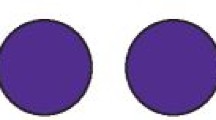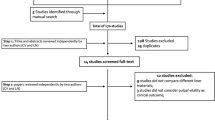Abstract
Objectives
This study aimed to systematically review the literature regarding the risk of selective removal—in comparison with stepwise and nonselective removal—of carious tissue in permanent teeth.
Materials and methods
Controlled clinical trials and cohort studies involving patients with dental caries in permanent teeth were included. Databases used were PubMed, Embase, and Scopus. The test group should be composed of patients undergoing selective removal of carious tissues, and the control group should comprise patients undergoing nonselective removal and/or stepwise removal of carious tissue. Laboratory tests, studies on primary teeth, and studies that used temporary restorations were excluded, as were literature reviews. The primary outcome was overall success of maintaining pulpal health (both clinically and radiographically). Quality of the restoration, pulp exposure, dentin deposition, and microbiological examination were also assessed. A meta-analysis, using the pooled risk ratio (RR) and its 95% confidence interval (CI), was performed to assess the success of maintaining pulpal health, using the different control treatments as a subgroup analysis.
Results
A total of 2333 articles were retrieved, of which 10 were included in the systematic review and four in the meta-analysis. In the qualitative evaluation, the control groups presented a higher risk of pulp exposure in relation to the selective removal. In the meta-analysis, the selective carious tissue removal showed significantly higher overall success (RR, 95% CI 1.11, 1.02–1.21).
Conclusions
The selective carious tissue removal presented higher success of maintaining pulpal health.
Clinical relevance
In permanent teeth, selective carious tissue removal should be performed, as this technique results in lower numbers of pulp complications, such as pulp exposure, as compared with nonselective removal.




Similar content being viewed by others
References
Manton D (2013) Partial caries removal may have advantages but limited evidence on restoration survival. Evid Based Dent 14:74–75. https://doi.org/10.1038/sj.ebd.6400948
Schwendicke F, Frencken J, Innes N (2018) Caries excavation: evolution of treating cavitated carious lesions. Karger Medical and Scientific Publishers, Basel
Schwendicke F, Stolpe M, Meyer-Lueckel H, Paris S, Dorfer CE (2013) Cost-effectiveness of one-and two-step incomplete and complete excavations. J Dent Res 92:880–887. https://doi.org/10.1177/0022034513500792
Casagrande L, Seminario AT, Correa MB, Werle SB, Maltz M, Demarco FF, Araujo FB (2017) Longevity and associated risk factors in adhesive restorations of young permanent teeth after complete and selective caries removal: a retrospective study. Clin Oral Investig 21:847–855. https://doi.org/10.1007/s00784-016-1832-1
Bitello-Firmino L, Soares VK, Damé-Teixeira N, Parolo CCF, Maltz M (2018) Microbial load after selective and complete caries removal in permanent molars: a randomized clinical trial. Braz Dent J 29:290–295. https://doi.org/10.1590/0103-6440201801816
Maltz M, Garcia R, Jardim JJ, Paula LM, Yamaguti PM, Moura MS, Garcia F, Nascimento C, Oliveira A, Mestrinho HD (2012) Randomized trial of partial vs. stepwise caries removal: 3-year follow-up. J Dent Res 91:1026–1031. https://doi.org/10.1177/0022034512460403
Pratiwi AR, Meidyawati R, Djauharie N (2017) The effect of MTA application on the affected dentine remineralization after partial caries excavation (in vivo). Journal of Physics: Conf Series 884:012119. https://doi.org/10.1088/1742-6596/884/1/012119
Fusayama T (1997) The process and results of revolution in dental caries treatment. Int Dent J 47:157–166
Innes NP, Frencken JE, Bjorndal L, Maltz M, Manton DJ, Ricketts D, Van Landuyt K, Banerjee A, Campus G, Doméjean S, Fontana M, Leal S, Lo E, Machiulskiene V, Schulte A, Splieth C, Zandona A, Schwendicke F (2016) Managing carious lesions: consensus recommendations on terminology. Adv Dent Res 28:49–57. https://doi.org/10.1177/0022034516639276
Bjørndal L, Larsen T, Thylstrup A (1997) A clinical and micro-biological study of deep carious lesions during stepwise excavation using long treatment intervals. Caries Res 31:411–417. https://doi.org/10.1159/000262431
Bjørndal L, Larsen T (2000) Changes in the cultivable flora in deep carious lesions following a stepwise excavation procedure. Caries Res 34:502–508. https://doi.org/10.1159/000016631
Bjørndal L (2008) Indirect pulp therapy and stepwise excavation. Pediat Dent 30:225–229. https://doi.org/10.1016/j.joen.2008.02.035
Maltz M, Koppe B, Jardim JJ, Alves LS, Paula LM, Yamaguti PM, Almeida JCF, Moura MS, Mestrinho HD (2018) Partial caries removal in deep caries lesions: a 5-year multicenter randomized controlled trial. Clin Oral Investig 22:1337–1343. https://doi.org/10.1007/s00784-017-2221-0
Ricketts D, Lamont T, Innes NP, Kidd E, Clarkson JE (2013) Operative caries management in adults and children. Cochrane Database Syst Rev 3. https://doi.org/10.1002/14651858.CD003808.pub3
Li T, Zhai X, Song F, Zhu H (2018) Selective versus non-selective removal for dental caries: a systematic review and meta-analysis. Acta Odontol Scand 76:135–140. https://doi.org/10.1080/00016357.2017.1392602
Schwendicke F, Dörfer CE, Paris S (2013) Incomplete caries removal: a systematic review and meta-analysis. J Dent Res 92:306–314. https://doi.org/10.1177/0022034513477425
Higgins JP, Altman DG, Gotzsche PC, Juni P, Moher D, Oxman AD, Savovic J, Schulz KF, Weeks L, Sterne JA (2011) The Cochrane Collaboration’s tool for assessing risk of bias in randomised trials. Bmj 343:d5928. https://doi.org/10.1136/bmj.d5928
Wells G, Shea B, O’Connell D (2012) The Newcastle-Ottawa Scale (NOS) for Assessing the Quality of Nonrandomised Studies in Meta-Analyses. Ottawa, ON. http://www.ohri.ca/programs/clinical_epidemiology/oxford_web.ppt. Accessed 12 October 2018
Maltz M, Moura MS, Jardim JJ, Marques C, Paula LM, Metrinho HD (2010) Partial caries removal in deep lesions: 19-30 months follow-up study. Rev Fac Odontol 51:20–23
Maltz M, Jardim JJ, Mestrinho HD, Yamaguti PM, Podestá K, Moura MS, Paula LM (2013) Partial removal of carious dentine: a multicenter randomized controlled trial and 18-month follow-up results. Caries Res 47:103–109. https://doi.org/10.1159/000344013
Orhan AI, Oz FT, Ozcelik B, Orhan K (2008) A clinical and microbiological comparative study of deep carious lesion treatment in deciduous and young permanent molars. Clin Oral Investig 12:369–378. https://doi.org/10.1007/s00784-008-0208-6
Orhan AI, Oz FT, Orhan K (2010) Pulp exposure occurrence and outcomes after 1-or 2-visit indirect pulp therapy vs complete caries removal in primary and permanent molars. Pediatr Dent 32:347–355
Rando-Meirelles MPM, Tôrres LHN, Sousa M (2013) Twenty-four months of follow-up after partial removal of carious dentin: a preliminary study. Dentistry. 3:2161–1122.1000162. https://doi.org/10.4172/2161-1122.1000162
Kaukua N, Chen M, Guarnieri P, Dahl M, Lim ML, Yucel-Lindberg T, Sundstrom E, Adameyko I, Mao JJ, Fried K (2015) Molecular differences between stromal cell populations from deciduous and permanent human teeth. Stem Cell Res Ther 6:59. https://doi.org/10.1186/s13287-015-0056-7
da Rosa WLO, Lima VP, Moraes RR, Piva E, da Silva AF (2018) Is a calcium hydroxide liner necessary in the treatment of deep caries lesions? A systematic review and meta-analysis. Int Endod J 52:588–603. https://doi.org/10.1111/iej.13034
Oliveira EF, Carminatti G, Fontanella V, Maltz M (2006) The monitoring of deep caries lesions after incomplete dentine caries removal: results after 14–18 months. Clin Oral Investig 10:134–139. https://doi.org/10.1007/s00784-006-0033-8
Thompson V, Craig RG, Curro FA, Green WS, Ship JA (2008) Treatment of deep carious lesions by complete excavation or partial removal: a critical review. J Am Dent Assoc 139:705–712
Schwendicke F, Göstemeyer G (2016) Understanding dentists’ management of deep carious lesions in permanent teeth: a systematic review and meta-analysis. Implement Sci 11:142–153. https://doi.org/10.1186/s13012-016-0505-4
Kakudate N, Yokoyama Y, Sumida F, Matsumoto Y, Gordan VV, Gilbert GH (2019) Dentists’ practice patterns of treatment for deep occlusal caries: findings from a dental practice-based research network. J Dent 84:76–80
Oen KT, Thompson VP, Vena D, Caulfield PW, Curro F, Dasanayake A, Ship JA, Lindblad A (2007) Attitudes and expectations of treating deep caries: a PEARL Network survey. Gen Dent 55:197–203
Funding
This study was supported by the Brazilian Governmental Agency CAPES by using the Portal de Periódicos CAPES. The first author was supported by a CAPES (National Council for the Improvement of Higher Education) scholarship funded by the Brazilian government during her Ph.D course, when this research was conducted.
Author information
Authors and Affiliations
Corresponding author
Ethics declarations
Conflict of interest
The authors declare that they have no conflict of interest.
Ethical approval
This article does not contain any studies with human participants or animals performed by any of the authors.
Informed consent
For this type of study, formal consent is not required.
Additional information
Publisher’s note
Springer Nature remains neutral with regard to jurisdictional claims in published maps and institutional affiliations.
Rights and permissions
About this article
Cite this article
Barros, M.M.A.F., De Queiroz Rodrigues, M.I., Muniz, F.W.M.G. et al. Selective, stepwise, or nonselective removal of carious tissue: which technique offers lower risk for the treatment of dental caries in permanent teeth? A systematic review and meta-analysis. Clin Oral Invest 24, 521–532 (2020). https://doi.org/10.1007/s00784-019-03114-5
Received:
Accepted:
Published:
Issue Date:
DOI: https://doi.org/10.1007/s00784-019-03114-5




